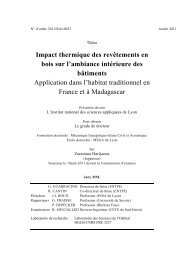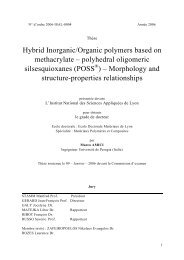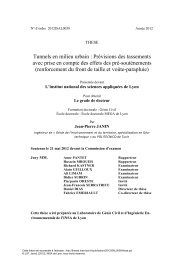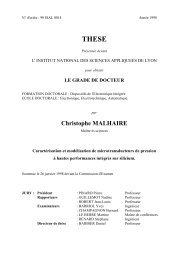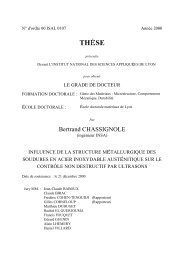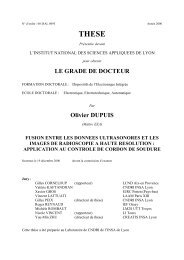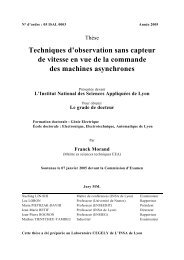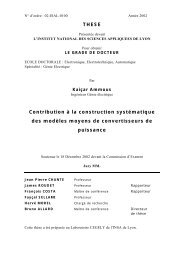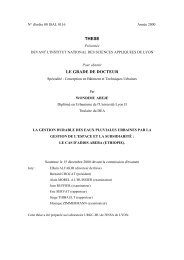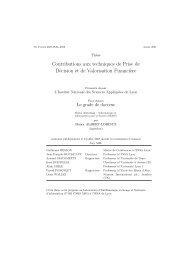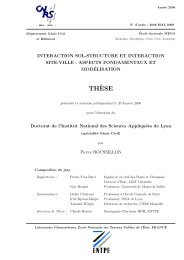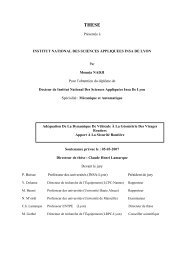- Page 1:
N° d’ordre 2006-ISAL-00109 Anné
- Page 4 and 5:
REMERCIEMENTS 4
- Page 6 and 7:
TABLE DES MATIÈRES 1.6 Application
- Page 8 and 9:
TABLE DES MATIÈRES Conclusion Gén
- Page 10 and 11:
TABLE DES FIGURES 2.5 Poutre encast
- Page 12 and 13:
TABLE DES FIGURES 4.3 Poutre avec d
- Page 14 and 15:
TABLE DES FIGURES 6.9 Erreur d’in
- Page 16 and 17:
TABLE DES FIGURES 6.26 Reconstructi
- Page 18 and 19: Introduction et contexte scientifiq
- Page 20 and 21: INTRODUCTION ET CONTEXTE SCIENTIFIQ
- Page 22 and 23: INTRODUCTION ET CONTEXTE SCIENTIFIQ
- Page 24 and 25: INTRODUCTION ET CONTEXTE SCIENTIFIQ
- Page 26 and 27: INTRODUCTION ET CONTEXTE SCIENTIFIQ
- Page 28 and 29: INTRODUCTION ET CONTEXTE SCIENTIFIQ
- Page 30 and 31: INTRODUCTION ET CONTEXTE SCIENTIFIQ
- Page 32 and 33: INTRODUCTION ET CONTEXTE SCIENTIFIQ
- Page 34 and 35: CHAPITRE 1. RECONSTRUCTION DE L’E
- Page 36 and 37: CHAPITRE 1. RECONSTRUCTION DE L’E
- Page 38 and 39: CHAPITRE 1. RECONSTRUCTION DE L’E
- Page 40 and 41: CHAPITRE 1. RECONSTRUCTION DE L’E
- Page 42 and 43: CHAPITRE 1. RECONSTRUCTION DE L’E
- Page 44 and 45: CHAPITRE 1. RECONSTRUCTION DE L’E
- Page 46 and 47: CHAPITRE 2. APPROXIMATIONS ET INCER
- Page 48 and 49: CHAPITRE 2. APPROXIMATIONS ET INCER
- Page 50 and 51: CHAPITRE 2. APPROXIMATIONS ET INCER
- Page 52 and 53: CHAPITRE 2. APPROXIMATIONS ET INCER
- Page 54 and 55: CHAPITRE 2. APPROXIMATIONS ET INCER
- Page 56 and 57: CHAPITRE 2. APPROXIMATIONS ET INCER
- Page 58 and 59: CHAPITRE 2. APPROXIMATIONS ET INCER
- Page 60 and 61: CHAPITRE 2. APPROXIMATIONS ET INCER
- Page 62 and 63: CHAPITRE 2. APPROXIMATIONS ET INCER
- Page 64 and 65: Chapitre 3 Validations Expérimenta
- Page 66 and 67: CHAPITRE 3. VALIDATIONS EXPÉRIMENT
- Page 70 and 71: CHAPITRE 3. VALIDATIONS EXPÉRIMENT
- Page 72 and 73: CHAPITRE 3. VALIDATIONS EXPÉRIMENT
- Page 74 and 75: CHAPITRE 3. VALIDATIONS EXPÉRIMENT
- Page 76 and 77: CHAPITRE 3. VALIDATIONS EXPÉRIMENT
- Page 78 and 79: Chapitre 4 Identification des condi
- Page 80 and 81: CHAPITRE 4. IDENTIFICATION DES COND
- Page 82 and 83: CHAPITRE 4. IDENTIFICATION DES COND
- Page 84 and 85: CHAPITRE 4. IDENTIFICATION DES COND
- Page 86 and 87: CHAPITRE 4. IDENTIFICATION DES COND
- Page 88 and 89: CHAPITRE 4. IDENTIFICATION DES COND
- Page 90 and 91: Chapitre 5 Reconstruction de l’ef
- Page 92 and 93: CHAPITRE 5. RECONSTRUCTION DE L’E
- Page 94 and 95: CHAPITRE 5. RECONSTRUCTION DE L’E
- Page 96 and 97: CHAPITRE 5. RECONSTRUCTION DE L’E
- Page 98 and 99: CHAPITRE 5. RECONSTRUCTION DE L’E
- Page 100 and 101: CHAPITRE 5. RECONSTRUCTION DE L’E
- Page 102 and 103: CHAPITRE 5. RECONSTRUCTION DE L’E
- Page 104 and 105: CHAPITRE 5. RECONSTRUCTION DE L’E
- Page 106 and 107: CHAPITRE 5. RECONSTRUCTION DE L’E
- Page 108 and 109: Chapitre 6 Approximations et incert
- Page 110 and 111: CHAPITRE 6. APPROXIMATIONS ET INCER
- Page 112 and 113: CHAPITRE 6. APPROXIMATIONS ET INCER
- Page 114 and 115: CHAPITRE 6. APPROXIMATIONS ET INCER
- Page 116 and 117: CHAPITRE 6. APPROXIMATIONS ET INCER
- Page 118 and 119:
CHAPITRE 6. APPROXIMATIONS ET INCER
- Page 120 and 121:
CHAPITRE 6. APPROXIMATIONS ET INCER
- Page 122 and 123:
CHAPITRE 6. APPROXIMATIONS ET INCER
- Page 124 and 125:
CHAPITRE 6. APPROXIMATIONS ET INCER
- Page 126 and 127:
CHAPITRE 6. APPROXIMATIONS ET INCER
- Page 128 and 129:
CHAPITRE 6. APPROXIMATIONS ET INCER
- Page 130 and 131:
CHAPITRE 6. APPROXIMATIONS ET INCER
- Page 132 and 133:
CHAPITRE 6. APPROXIMATIONS ET INCER
- Page 134 and 135:
CHAPITRE 6. APPROXIMATIONS ET INCER
- Page 136 and 137:
CHAPITRE 6. APPROXIMATIONS ET INCER
- Page 138 and 139:
CHAPITRE 7. VALIDATIONS EXPÉRIMENT
- Page 140 and 141:
CHAPITRE 7. VALIDATIONS EXPÉRIMENT
- Page 142 and 143:
CHAPITRE 7. VALIDATIONS EXPÉRIMENT
- Page 144 and 145:
CHAPITRE 7. VALIDATIONS EXPÉRIMENT
- Page 146 and 147:
CHAPITRE 7. VALIDATIONS EXPÉRIMENT
- Page 148 and 149:
CONCLUSION GÉNÉRALE Des fonctions
- Page 150 and 151:
Annexe A Calcul détaillé de l’
- Page 152 and 153:
ANNEXE A. CALCUL DÉTAILLÉ DE L’
- Page 154 and 155:
ANNEXE B. INTÉGRATION NUMÉRIQUE 1
- Page 156 and 157:
ANNEXE B. INTÉGRATION NUMÉRIQUE 1
- Page 158 and 159:
ANNEXE C. CALCUL DÉTAILLÉ DE L’
- Page 160 and 161:
ANNEXE C. CALCUL DÉTAILLÉ DE L’
- Page 162 and 163:
ANNEXE C. CALCUL DÉTAILLÉ DE L’
- Page 164 and 165:
Annexe D Singularités des contours
- Page 166 and 167:
ANNEXE D. SINGULARITÉS DES CONTOUR
- Page 168 and 169:
Annexe E Compléments sur les fonct
- Page 170 and 171:
ANNEXE E. COMPLÉMENTS SUR LES FONC
- Page 172 and 173:
Annexe F Liste des communications s
- Page 174 and 175:
BIBLIOGRAPHIE [DS 85] DESANGHERE G.
- Page 176 and 177:
BIBLIOGRAPHIE [MOO 03] [MSW 94] MOO
- Page 178 and 179:
BIBLIOGRAPHIE [TA 76] [TAR 87] TIKH
- Page 180:
FOLIO ADMINISTRATIF THESE SOUTENUE



